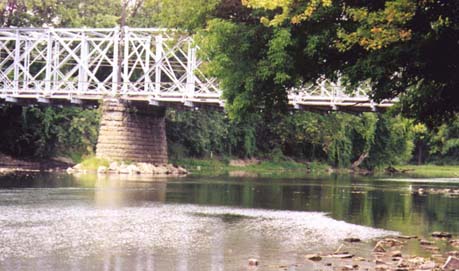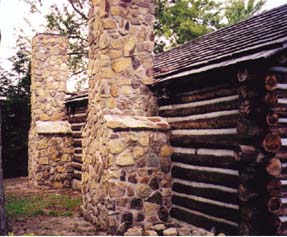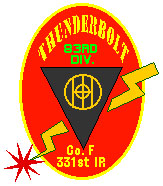

Scot Jamie (or "Scotch Jemmy") came to Pennsylvania in 1785 from Dumfries Scotland. He and his family first landed at Philadelphia, and soon after relocated to Pittsburgh. In 1793 they poled up the Allegheny River and into French Creek. The trip was not without peril--the boat capsized half way through the voyage, and many possessions were lost. They settled in the Meadville area, which at the time was part of the western frontier. The story is retold in "A Remarkable Life," the biography of his son Joseph Dickson which appeared in the Centennial Edition of the Tribune-Republican newspaper on May 12, 1888. Keep this publishing date in mind to avoid confusion--the present day referred to in this material is actually 1888. Also, note that the "Mr. Dickson" in the following material usually--but not always--refers to James Dickson's son, Joseph. As a result, the material must be read with some care to keep the personalities straight. Another point of confusion concerns the block house and the double log cabin. Family history always had the Dicksons originally living in the double cabin. It is possible that this cabin and the blockhouse were one and the same, but it is difficult to determine whether this is so from the 1888 story. The present-day photos are of French Creek and a modern replica of the double log cabin, which is located near the site of the original settlement.
James Dickson was born near Dumfries, Scotland, in 1754. He was married December 12th 1782 to Barbara Brown by Rev. John Ewart. Having taken a lively interest in the struggles of the American colonies for independence, he determined to make his home in the new world. In the fall of 1785 he landed at Philadelphia with his wife and two children. They had been eight weeks on the ocean. Remaining but a short time in Philadelphia, the family went west as far as Pittsburg. It was the intention of Mr. Dickson to take up land at once, but the unsettled state of the frontier made it imprudent to do this, and accordingly he remained in or about Pittsburg for several years. Three children were born while there, and three after their removal to Meadville. In all there was a family of eight children. Joseph Dickson was the fourth child. He was born February 12, 1790, on the south side of the Monongahela river, opposite Pittsburg. The place which was afterwards called Birmingham, is now included in the city limits. The family afterwards removed farther down the river, and lived near the mouth of Saw Mill Run. Mr. Dickson can remember watching his older brother push cakes of ice into this run during a freshet which occurred during the spring of 1794. James Dickson came to Meadville alone early in 1793. It is not known how he made his way hither. He remained all summer and raised some corn and potatoes, either on the Island or on the Vallonia flats. These he stored for the use of his family the next season, and returned in the fall to Pittsburg. Next spring, 1794, as soon as the river was safe for navigation, which was some time in April, the family was placed in a small keel boat, in which they were to ascend the Allegheny, as far as Franklin, and thence by way of French Creek to Meadville. In crossing Pittsburg to take the boat they passed through the woods where now is the most densely populated portion of the city.
These he stored for the use of his family the next season, and returned in the fall to Pittsburg. Next spring, 1794, as soon as the river was safe for navigation, which was some time in April, the family was placed in a small keel boat, in which they were to ascend the Allegheny, as far as Franklin, and thence by way of French Creek to Meadville. In crossing Pittsburg to take the boat they passed through the woods where now is the most densely populated portion of the city.
They brought with them furniture and utensils adapted to frontier life. Among other things there was a hand-mill, which was used for several years by the entire population of Meadville. Mr. Dickson distinctly remembers seeing this mill fastened to a post in front of his father's house, on Water Street. The balance wheel was made heavier by means of four cannon balls placed on opposite sides, and connected by iron rods. After it acquired considerable momentum, the weight of these balls kept the mill in motion without much effort on the part of the grinder. This mill, or a part of it, is now in possion of A.B. Richmond, Esq. The voyage up the river was long and tire some, as the boat had to be poled by men the entire distance. When they reached a point near the present town of Parker they met with a serious accident. In poleing up through swiftly flowing water, called in river language a riffle, the man at the bow lost his hold, and the boat swung around against a rock, being nearly capsized. The current washed away some of their clothing, provisions and other property.
It was with great difficulty that the mother and children were carried to the shore. Owing to the rapid current the men could not stand in the water, till at length one of them secured a foot hold and held the poles as a railing for the others. Mr. Dickson remembers being carried ashore on the back of one of the men, who said to him as he clung about his neck, "if you don't hold on I'll throw you into the river." The family remained on the bank of the river nearly a week before another boat came along, on board of which they were taken. At Franklin they obtained supplies in place of those which had been lost, and during the second week in May they reached their destination. They at once found shelter in the block house. Mr. Dickson's recollection of this block house is that it was a small log structure built square and but one-story high. In 1795 a new block house was constructed of hewn logs, at a short distance from the fort. This building is remembered by many of our older citizens, but it must not be confounded with the first block house. Around this there was a stockade, considerably higher than a man's head, enclosing an area of about half an acre. Within the enclosure General Mead had two log houses under the same roof, with a covered passage between them. The Dickson family remained in the block house all that summer.
Within the enclosure General Mead had two log houses under the same roof, with a covered passage between them. The Dickson family remained in the block house all that summer.
During the year 1794, William Dick, William Gill, Thomas Ray, William Jones, Thomas Rallyea and others, some of them with their families, arrived at the settlement. The Meads, Randolphs, Van Hornes, Lords, and a few other had arrived previously. On the 10th of August of this year an event occurred which will cause the name of James Dickson always to be associated with the early history of our city. For some time there had been rumors of an Indian attack. It had been stated that the Cornplanter Indians had threatened to drive the settlers from French Creek, if they were not at once removed by the government. On the day named Mr. Dickson was walking out north of the town with his gun in hand, for in those days no one went into the woods unarmed. He had reached a point near the intersection of Spring Street and Terrace, a short distance south of Athen's Mills, when he heard a sound which he supposed to be made by a deer. He stood still for an instant, thus making himself an easy mark, and heard three shots fired sumultaneously by as many Indians. Each bullet struck him--one passed through his left hand, splitting the little finger from the others. A second struck him in the breast, and lodged between the breast bone and shoulder blade, where it ever afterward remained. The third shot took effect in the left hip and lamed him slightly. Instinctively, Mr. Dickson brought the gun to his shoulder and prepared to fire, but no enemy was to be seen . All that  appeared was a rifle pointed at him, and knowing that there must be a head behind it, he took aim along the barrel. But before he could fire the rifle was discharged; the bullet cut his cap, but did not touch him. This roused his Scotch blood, and he called to the savages, "Come out, ye cowards, and give me fair play!" Two showed themselves, running from tree to tree, till one was on each side of him. Mr. Dickson was about to seek the shelter of a tree, when it occurred to him that he was surrounded, and that as the guns of his enemies were empty, he must act promptly. Accordingly he pointed his gun toward the Indian who was between him and the fort, and he drove him from his shelter. Then with his finger on the trigger, and walking backward, he kept the Indians in check till he reached Samuel Lord's log cabin, near the present residence of William Reynolds. By that time one of his pursuers had reloaded, and another shot was fired at him, but he was not again struck. The Indians then bounded out of sight, going down towards the creek. The wounded man made his way as rapidly as possible towards the block house. When near the location of Red Mill he met Samuel Lord, John Wentworth, Luke Hill and a friendly Indian named Flying Cloud, going out to his relief. They passed on and followed the trail of the attacking party across the creek, but owing to the thickness of the underbrush on the other side, they did not think it prudent to continue the pursuit.
appeared was a rifle pointed at him, and knowing that there must be a head behind it, he took aim along the barrel. But before he could fire the rifle was discharged; the bullet cut his cap, but did not touch him. This roused his Scotch blood, and he called to the savages, "Come out, ye cowards, and give me fair play!" Two showed themselves, running from tree to tree, till one was on each side of him. Mr. Dickson was about to seek the shelter of a tree, when it occurred to him that he was surrounded, and that as the guns of his enemies were empty, he must act promptly. Accordingly he pointed his gun toward the Indian who was between him and the fort, and he drove him from his shelter. Then with his finger on the trigger, and walking backward, he kept the Indians in check till he reached Samuel Lord's log cabin, near the present residence of William Reynolds. By that time one of his pursuers had reloaded, and another shot was fired at him, but he was not again struck. The Indians then bounded out of sight, going down towards the creek. The wounded man made his way as rapidly as possible towards the block house. When near the location of Red Mill he met Samuel Lord, John Wentworth, Luke Hill and a friendly Indian named Flying Cloud, going out to his relief. They passed on and followed the trail of the attacking party across the creek, but owing to the thickness of the underbrush on the other side, they did not think it prudent to continue the pursuit.
It was supposed that the attack on Mr. Dickson was intended for a feint to draw the men away from the fort, when another party would attack the unprotected women and children. But no such attack was made, and as soon as the news of Wayne's victory reached the Indians all who were unfriendly at once disappeared. Mr. Joseph Dickson's recollections of the scenes of that day was very clear. In company with the other children of the settlement, he was playing on the bank of the creek immediately in the rear of Mr. McFarland's house. Suddenly a man came running down and hurried them all inside of the stockade. Shortly after this his father came in, gun in hand, and covered with blood. He was very much excited. Mrs. Dickson was of course alarmed, and, running towards her husband, who, having seen his family safely housed was about to go out again, said, "Stop; let me wash your wounds." His Scotch blood was still up, and he ran out into the yard saying: "Let me alone! I'll have revenge on the yellow rascals." The wounds never had a surgeon's care, though they were dressed as carefully as the circumstances would permit, and they soon healed.
On the 10th of August, 1794, James Dickson, a native of Scotland (familiarly known as "Scotch Jemmy"), and a pioneer to French Creek, was passing along the path that ran up the east bank of the stream in search of his cows, and upon reaching the spot near where the barn of Hon. William Reynolds now stands, heard a noise in the bushes, and thinking it was a deer, and being armed with his trusty rifle, he stood still so as to secure a good shot as soon as the animal should appear. While thus waiting three guns were discharged at him, one ball struck him in the left hip, one in the right shoulder, and a third passed through his left hand. Discovering the barrel of another rifle pointed from the bushes, he instantly leveled his gun to shoot, but at that moment his hidden foe fired, the ball passing through Dickson's hat and grazing the top of his head. The brave Scot stood his ground and shouted to the savages: "Come out you cowardly dogs and fight me fair." Two indians, tomahawk in hand, immediately sprang from their hiding place, but the fear of the Scotchman's rifle soon caused them to seek protection behind trees, one to his right and the other to his left, thus intending to attack him from both quarters at once, and get between him and the village. Dickson concluded to reserve his fire knowing that therein lay his only safety, and by menacing each in turn he managed to keep them at bay, one of whom, however, had in the meantime loaded his gun and again fired at the Scotchman, but missed. The Indians fearing a rescue party from Mead's Blockhouse, soon gave up the battle and disappeared in the forest, leaving the hardy pioneer victor of the field. He at once started for the village, but ere reaching the little cluster of cabins which then comprised Meadville, he met Samuel Lord, John Wentworth, Luke Hill and Flying Cloud, coming to his assistance. This party pursued the savages, but the latter had made good their escape, and were not overtaken. Mr. Dickson, wounded and bleeding, reached the cabin where his wife and children were living, and after washing off the blood that covered him, was with difficulty restrained by his wife and friends from joining in the pursuit, as he said: "I want revenge on the bloody rascals." His son, now the venerable Joseph Dickson, still living in Meadville, was then only four years old, and he said: "I well remember seeing my father coming into the cabin, his clothes covered with blood, which streamed from his wounds, and I also remember how much trouble my mother had to keep him from following the Indians." Mr. Dickson when speaking of the fight always claimed that at one time when about to fire at the Indians, he distinctly heard a voice saying: "Dinna shoot: Dinna shoot: Dinna be afraid, they canna kill ye." The bullet received in his shoulder during this conflict, remained in his body until his death, some thirty years afterward.
The drawing of "Scotch Jemmy" shown below is the original sketch made for the Crawford County Trust Company advertisement that is at the top of this page. The sketch hung in the main office of the bank building for many years, but disappeared sometime after the bank was purchased by Mellon Bank of Pittsburgh, Pa.

Missing for nearly 30 years, the sketch--still in its original frame--suddenly reappeared. Walter J. Morrison III, an art collector, wrote to me saying that he had the original. He had found it in an antique store near Buffalo, NY. Just as Walt does with all of the art that he buys, he researched the drawing on the internet and, to his surprise, found this page. Thanks to Walt, the drawing is now home again. We wonder what places it has seen in its three-decade journey?
